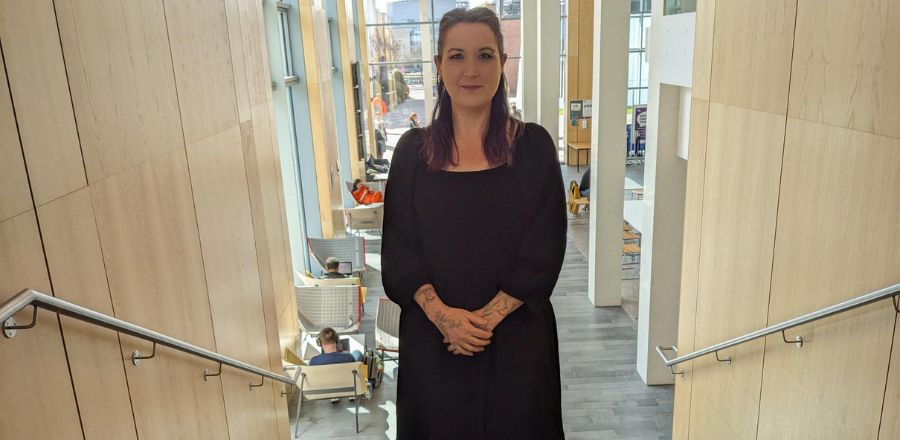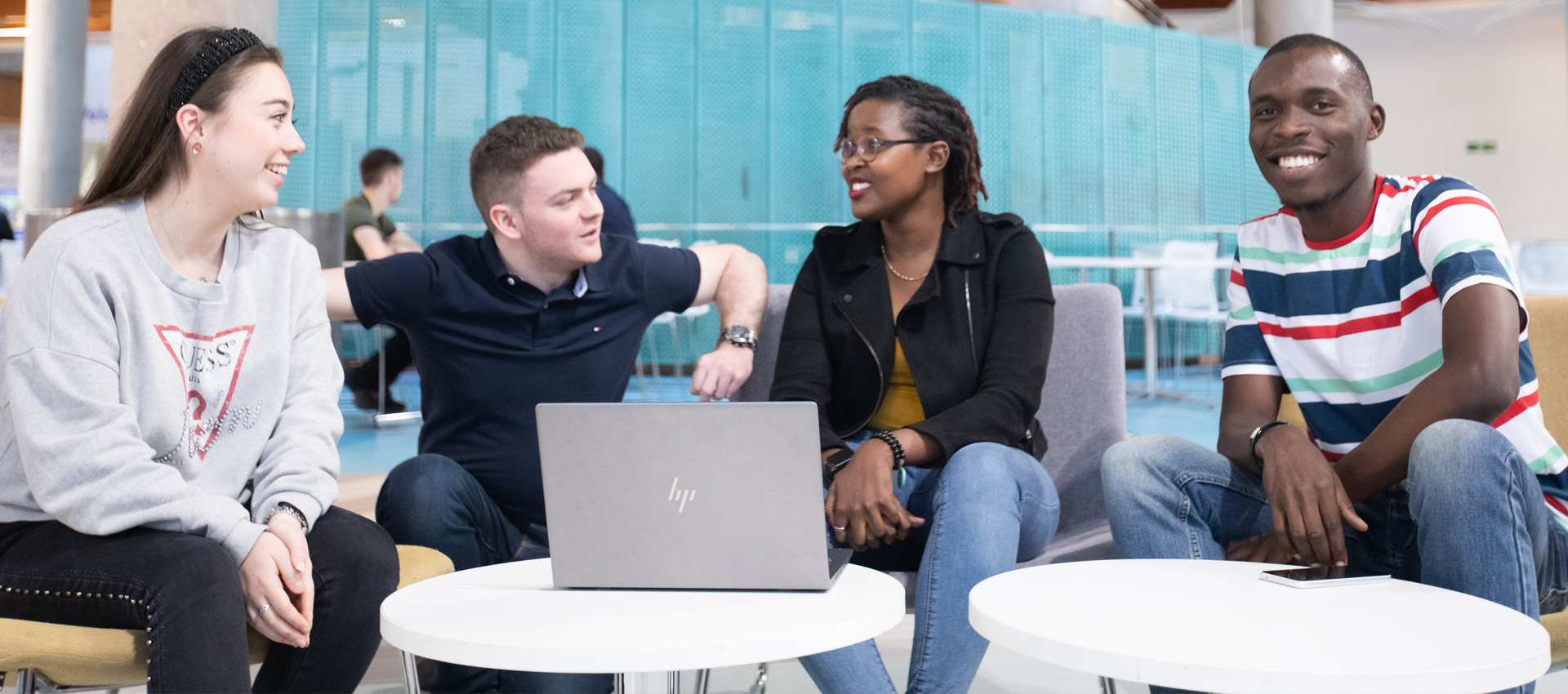“There’s been a lot of learning, and not just for the young people involved!” – student reflects on inspirational project

A GCU Masters student has been involved in delivering an innovative pilot project aimed at helping young people tackle the stigma around poverty.
Robyn Lock moved from Australia to study MSc International Economics and Social Justice at GCU. Her degree involves professional practice, a placement over two trimesters which allows students to develop their knowledge and professional skills.
During her second year, Robyn teamed up with West Dunbartonshire Citizens Advice Bureau and helped to deliver the Our Voices, Our Stories: Young People Challenging Poverty Stigma and Inspiring Change project with S1 pupils at Clydebank’s St Peter the Apostle High School.
Grounded in the Redefining Poverty Model, Robyn's own work which she adapted, the approach was framed by Bronfenbrenner’s Bioecological Systems Theory, with stigma treated as a proximal process that distorts the lived realities of poverty.
The aim of the overall project delivered is to help young people explore issues of poverty and social exclusion through character creation, storytelling, and visual art.
We caught up with Robyn to hear more about her journey and the success of the programme:
Tell me a bit about your background and interest in social justice?
“I had been studying at Griffith University since 2016. My dissertation for my Honours degree in Human Services focused on stigma in the long-term unemployed, and that’s where a lot of my drive and ambition comes from.
“I wanted to see change and put lived experience on it because there wasn’t really much of that out there. There was a lot of academics and policy makers trying to explain it without really listening to the people that have lived in those situations.
“I myself come from that background. I grew up in a regional town in Queensland before we moved to Brisbane. It was a single-parent household and she was on welfare payments. Life wasn’t really expecting anything from me. It was a huge challenge for me to go to University because I didn’t complete my final year of high school.”
How did you come to Scotland?
“My partner and I have been together for 12 years. We came here on holiday back in 2019 and knew we would obviously fall in love with it – and that was exactly what happened! We knew we wanted to live here but covid then got in the way and delayed things slightly.
“I knew I wanted to continue the work I was doing and the MSc in International Economics and Social Justice really appealed to me because of the professional practice opportunity.
“Before coming to Scotland, I also made sure I was aligned to the country. I was aware of the big push towards child poverty and how there had been a lot of different programmes set up. There is a general feeling here that we’re not doing enough but I certainly felt like Scotland was well advanced – especially in comparison to Australia. We don’t have anything like free school meals, so I was really interested in coming over and fitting into that.”
How did you come to secure your professional practice with West Dunbartonshire Citizens Advice Bureau?
“I owe so much to my lecturer Dr Angela O’Hagan – it all starts with her. We were coming up to the professional practice part of the degree and all of us, as international students, on this relatively new course had no idea how to really approach it.
“Angela was running the MSc Human Rights course and taught two of the modules on my course. She had a connection at Citizens Advice Bureau and I got in touch with the CEO. They had a placement available but had never taken on a student before. Thankfully, they agreed and it started this crazy adventure.
“I did a lot of shadowing to start and some outreach work in the community. It was really good for me to experience a general overview of the organisation – and that led us to this incredible project.”
How did Our Stories, Our Strength come to fruition?
“I basically heard about this guy who was working at a foodbank at a church in Clydebank. They were offering a £200 grant to people who were there to collect food parcels, but there was a bit of pushback because there was a real stigma attached to people receiving grants. I was genuinely really surprised about the attitude to it and it just didn’t make sense to me. I couldn’t really understand why people would feel that way towards receiving money.
“It really got me thinking and reflecting on the work I had done with the long-term unemployed back in Australia around the stigma they faced when it came to receiving benefits – it’s a similar system to the United Kingdom.
“The CEO at West Dunbartonshire CAB, Joe McCormack, had said that they wanted to do more work with schools. That led me to this idea about going into classrooms and talking to the young people about stigma so that they can then educate their parents.
“After a few different meetings it was agreed we would deliver it to S1 pupils at St Peter the Apostle in Clydebank. We had a meeting in December and then followed that on with our first session in January – so it has been very fast!”
Empathy, kindness, diversity and inspiring positive change is a big part of the overall project, but you also got the pupils to create their own comic book. Tell me a bit about that?
“It’s actually inspired by my daughter. She’s four years old and was sent home from nursery with these Ziggy books about road safety. They’re created as a comic book by the Scottish Government. It basically focused on being safe, holding hands and wearing helmets when you ride bikes - there’s like a family element to it.
“I basically wanted the S1 pupils to have the creative freedom because having adults impose on children through policy and telling them what to do was my original problem and I didn’t want to be perpetuating that. I obviously wanted to give them background information to help broaden their minds but I wanted them to then tell their story and make it meaningful and impactful without it being boring. There are definitely a lot of firsts within the project but everyone has been really onboard with the idea and up for giving it a go.”
The project is obviously now well under way, how has it all been going?
“There’s been a lot of learning, and not just for the young people involved! There are four or five of us delivering the sessions and none of us have actually worked with S1 pupils before, so it has been a real team effort.
“I knew going into that first session that I was really nervous and that the pupils wouldn’t have much idea what was going on, so I basically just got them to stand up and yell as part of a welcoming exercise – it was great. We now do that every session.
“We break them up into four groups and have a facilitator with each group. It really allows us to capture the thoughts of these young people and essentially gather the research in an informal environment. It was interesting at first because it felt like the pupils maybe didn’t want to get it wrong, but the beauty of this is that there is no right or wrong.
“We’ve actually only got 45 minutes with them, so it all goes in really quick but the school has been amazing at allowing us to have extra sessions. Trust is a big thing with projects like this and I do really feel like we’ve been able to develop that over the course of the time there."
What are the pupils going to create by the end of the project?
“Each group are putting together their own story with their own characters. Every pupil has their own role, so one might be focusing on story development while another does the drawing – no-one is left out.
“We’ve had some really cool characters created including; Sassy Susan, Lightbulb Liam and Balloon Boy Bob. We gave each group some different photos to help spark some inspiration and that was their starting point. One group began at home and we also had places like the park and in the city. The first session focused on including empathy and inclusion. Other than that, it was really organic. They were able to reflect on their own experiences and you can see it is helping them express different situations they have faced in their life.
“A great example is Balloon Boy Bob and Lightbulb Liam because the story with them reflects on the boys being really good at football but not being able to afford the necessary kit to play. This shows the stigma or issue they could face.
“They do clearly understand stigma and what’s right and wrong, but they don’t know the language to get it across. This led to us developing a 17-page glossary, which originally wasn’t planned for the project. It’s an easy way for us to explain the different terms that we’re using; words like stereotypes, prejudiced, poverty and what it means in the context we’re talking about.”
“The final part of the project focused on how community services help people, which included things like Citizens Advice and foodbanks. We wanted the end of the stories to be where they end up actually getting help. Doing this with the characters then allows these young people to know what support is there for them. We just want them to know that they are never alone.”
What are the next steps with the project?
“We’re actually going to have a publisher come in to really finalise the project. He will run a workshop explaining how to visualize and develop the characters.
“The focus of the pupils has been on drawing and verbally telling us the story – the tough bit is the actual writing part. The publisher is really going to help with this by basically transcribing everything and bringing their stories to life. The whole project will culminate in June with the books being created and given back to the pupils involved.
“We’re also looking at running this project again in future and having the current S1 pupils we've worked with involved as Ambassadors. They are going to give us lots of feedback on their experience of being involved and help develop the programme for the next group we work with.”
You’re obviously due to graduate this month, what’s your future plans?
“I'm actaully now going to be completing a PhD titled 'Developing Stigma-Informed Programme Eligibility: A Feasibility Study to Integrate Lived-Experience Indicators into Poverty Support Systems'.
"I'm looking forward to continuing my work. I would like to say a special thanks to Professor John McKendrick, Professor Stephen Sinclair and Dr Nina Teasdale who encouraged and supported me in this successful application, and will form my supervision team.
“For now, I’m just really excited to see how everything finishes up at St Peter the Apostle. I’m just so proud of the team effort behind it all and I can’t thank everyone involved enough. I would also like to mention the incredible support of SPIRU and WiSE (GCU)."
Find out more about the MSc International Economics and Social Justice degree here
By Ross Clark
Got an SHLS or GSBS story? Email me at Ross.Clark@gcu.ac.uk or message me on Twitter
